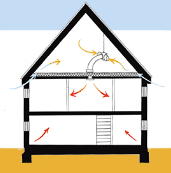Table of content
Breathing dirty air is like drinking dirty water.
PIV (Positive Input Ventilation) units create a positive pressure in the house to force air changes.
We set out the advantages and disadvantages of PIV.
What is a PIV Unit
PIV (Positive Input Ventilation) is a method of ventilating a space using air pressure to create air movement. Air will move from high pressure to low pressure. So for example in a house, if you pressurise the house with a fan, air will move from this location to the exterior. How the air moves from this high pressure house to the exterior I will discuss later.
The principle behind PIV Units
A PIV unit is easy to install, it usually sits in the attic and pumps air into the house via a hole in the ceiling. Air is taken from the attic space filtered for dust and then pumped into the house. Some units have heaters to warm the air before it enters the house.
If your house is constructed reasonably well with due consideration to air tightness and insulation you must consider ventilation to prevent the build up of stale air which will lead to an unhealthy environment for the house and it occupants. Mould can form on some areas after condensation build up.
For this high pressure air to leave the house special ventilation holes must be made in the exterior of the home either in the windows with trickle vents or vent hole in the walls.
Advantages of PIV Units
- Easy to install.
- Not an expensive option
- The unit will ventilate the home if set up correctly.
- Filters the air as it enters the home.
- Heats the air in winter to assist with home heating
- Helps to reduce air bourn pollutants
Disadvantages of PIV units
- Brings cold air from the attic into the house in winter.
- Brings warm air ( or very hot air) into the house during the summer, when you are trying to cool the house down.
- If you live in an older house and apply positive pressure to your home you run the risk of introducing interstitial condensation into the fabric of the building, which could lead to mould growth and degrading of the building fabric.
- In a newer type home with reasonable air tightness and insulating the exterior vents must be designed to allow the correct air flows from each room.
- Can cause more moisture in the attic in winter.
- Creating positive pressure in the home will not allow for the correct extraction where required.
Ventilation Success Stories
Ventilation success stories come from people who have invested in the technology, quick fix solutions to an existing issue can sometimes give greater issues.
Some background information for you
Finally..
Be careful what you are being sold. PIV ventilation can cause more problems than solutions. A system needs to be designed by a professional ventilation Engineer who will develop the most appropriate options for you.

